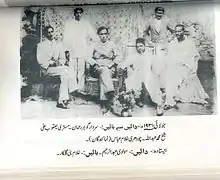1931 Kashmir agitation
A widespread agitation throughout the princely state of Jammu and Kashmir in British Raj occurred in 1931 against the Maharaja's government. The Maharaja was forced to appoint the Glancy Commission to investigate the people's concerns. Various political reforms were adopted including the introduction of the Jammu and Kashmir Praja Sabha (legislative assembly). The movement also saw the rise of Sheikh Muhammad Abdullah as the leader of Kashmiris.
 (Seated, right to left): Sardar Gohar Rehman, Mistri Yaqoob Ali, Sheikh Abdullah and Chaudhary Ghulam Abbas. (Standing): Molvi Abdur Rahim (right) and Ghulam Nabi Gilkar | |
| Date | 13 July 1931 |
|---|---|
| Location | Central Jail, Srinagar |
| Type | Agitation |
| Cause | Alleged desecration of the Koran by a Dogra policeman[1] |
| Target | Kashmiri Pandits (Hindus) |
| Outcome | 500 soldiers sent to support Hari Singh and restore law and order |
| Deaths | 22 |
Events
On 13 July 1931, thousands of Kashmiris flocked to the central jail in Srinagar to see the trial of Abdul Qadeer. As the time for obligatory jumma prayer approached, a Kashmiri stood up to deliver the adhan. The Dogra governor, Ray Zada Tartilok Chand, ordered his soldiers to open fire on them, in total 22 Kashmiris died in the firing.[2] The people carried the dead through the streets of Srinagar, chanting slogans opposing Dogra brutality. The incident shook the state, and a week-long period of mourning was observed. Traffic between Srinagar, Rawalpindi and Jammu was halted from 13 to 26 July.[2] The protests intensified; anti-Hindu riots began, leading to the death of three Hindus, the wounding of many more and the looting of Hindu-owned shops.[3][4] The Hindus retaliated, leading to more clashes between the two groups.[5] The violence spread to Kashmir province and Jammu; three British companies, numbering about 500 soldiers, were sent to support Maharaja Hari Singh and restore law and order. The incident led to the rise of young Sheikh Abdullah, and his rivalry with the maharaja continued until 1947.[6]
Meeting with the maharaja
Muslim representatives, including Mirwaiz Yusuf Shah, Mirwaiz Hamadani, Syed Hussain Shah Jalali, Saad-ud-din Shawl, Sheikh Abdullah, Ghulam Ahmad Ashai, Yaqub Ali, Munshi Shahab-ud-Din, Chaudhry Ghulam Abbas and Gauhar Rehman, addressed the maharajah on 15 August.[7] They made a number of accusations against Hindus in general and the state administration and prime minister in particular, alleging that evidence given to the Riots Enquiry Committee was fabricated or suppressed.[7] The maharaja refused to dismiss the prime minister, and rejected the Muslim leaders' allegations as "unfounded".[7]
Temporary truce
The Muslim leaders were dissatisfied, but they met with the prime minister on 26 August and signed an agreement to end the agitation.[8]
Aftermath
The agitation temporarily subsided, primarily because of the Kashmir Darbar's conciliatory attitude toward its subjects (permitting Ahrar-i-Islam, Mazhar Ali Azhar and two companions to visit Kashmir privately). With the intervention of Muslim sympathisers outside Kashmir, 14 August was observed as Kashmir Day in Kashmir and several parts of India. Demonstrations and meetings were held in sympathy with Kashmiri Muslims. The meetings adopted resolutions calling for freedom of religion, the restoration of mosques and Muslim shrines, compensation for dependents of those killed or injured, and an investigation of the conduct of civil and military officers during the agitation.[9]
References
- Christopher Snedden (2015). Understanding Kashmir and Kashmiris. Hurst. p. 128. ISBN 978-1-84904-622-0.
- "Kashmir Martyrs Day observed". The Nation. 14 July 2015. Retrieved 13 April 2020.
- Devaraju Nagarjun (2015). Clash of Identities Ethnic Conflict of Kashmir Dispute. University of California. p. 6.
- Rekha Chowdhary (2004). Jammu and Kashmir: Politics of Identity and Separatism. Routledge. p. 30.
- Kwasi Kwarteng (2011). Ghosts of Empire: Britain's Legacies in the Modern World. Bloomsbury Publishing. p. 260.
- Christopher Snedden (2015). Understanding Kashmir and Kashmiris. Oxford University Press. p. 131.
- Kaur, Ravinderjit (1996). Political Awakening in Kashmir. APH Publishing. p. 154. ISBN 9788170247098.
- Kaur, Ravinderjit (1996). Political Awakening in Kashmir. APH Publishing. p. 154. ISBN 9788170247098.
- Kaur, Ravinderjit (1996). Political Awakening in Kashmir. APH Publishing. p. 153. ISBN 9788170247098.
Further reading
- Chawla, Muhammad Iqbal (2011), "Role of the Majlis-i-Ahrar Islam in the Kashmir Movement of 1931", Pakistaniaat: A Journal of Pakistan Studies, 3 (2): 82–102
- Copland, Ian (1981), "Islam and Political Mobilization in Kashmir, 1931-34", Pacific Affairs, 54 (2): 228–259, doi:10.2307/2757363, JSTOR 2757363
- Jalal, Ayesha (2002), Self and Sovereignty: Individual and Community in South Asian Islam Since 1850, Routledge, pp. 482–, ISBN 978-1-134-59937-0
- Rai, Mridu (2004), Hindu Rulers, Muslim Subjects: Islam, Rights, and the History of Kashmir, C. Hurst & Co, ISBN 1850656614
- Zutshi, Chitralekha (2004), Languages of Belonging: Islam, Regional Identity, and the Making of Kashmir, C. Hurst & Co. Publishers, ISBN 978-1-85065-700-2